This classic dish of northern Italy has a reputation for being time consuming and finicky, but when you understand the basics, it is actually rather simple. Let me show you how to make a basic risotto.

Having a basic risotto recipe in your arsenal is a great asset, as it is a dish that can be the foundation of your creativity and is sure to impress your family, friends and guests. You can do as much with risotto as you can do with pasta or plain cooked rice.
Key Ingredients in This Recipe

- Rice
- Stock – or broth
- Butter
- Onion – shallot, yellow or white onion
- White wine
- Parmesan cheese
How to Make a Basic Risotto
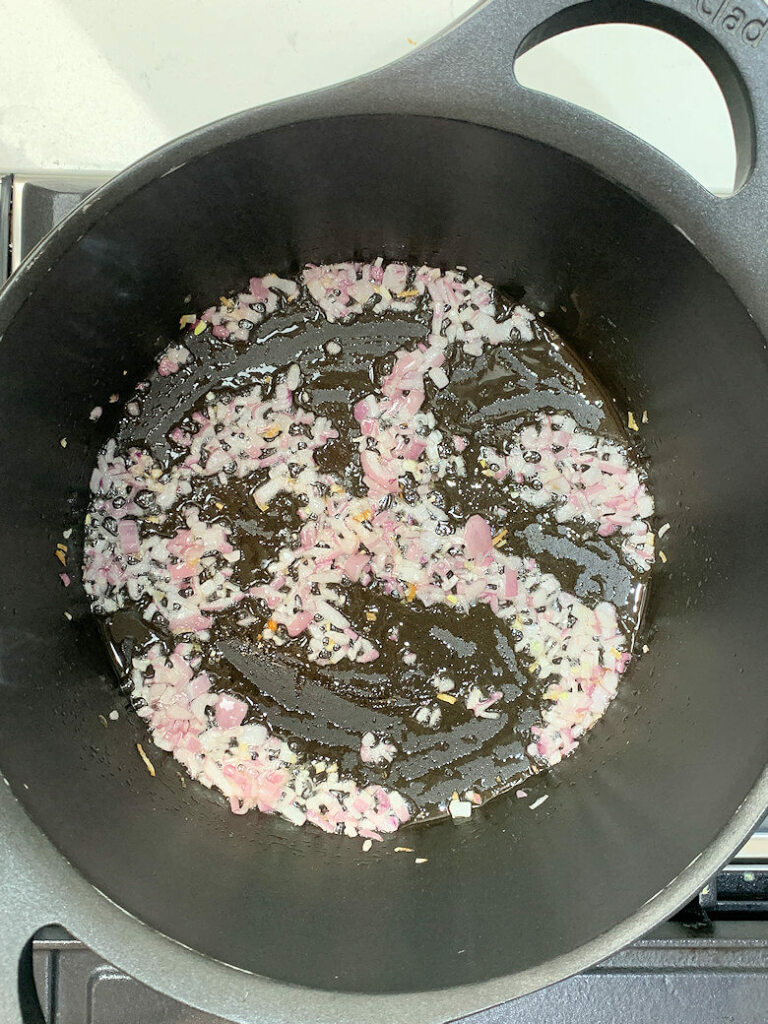
Step 1 – Melt the butter, add the onion and saute until tender and translucent. Do not caramelize the onions.
Step 2 – Add the rice and roast it by stirring it until you see white spots on the grains.
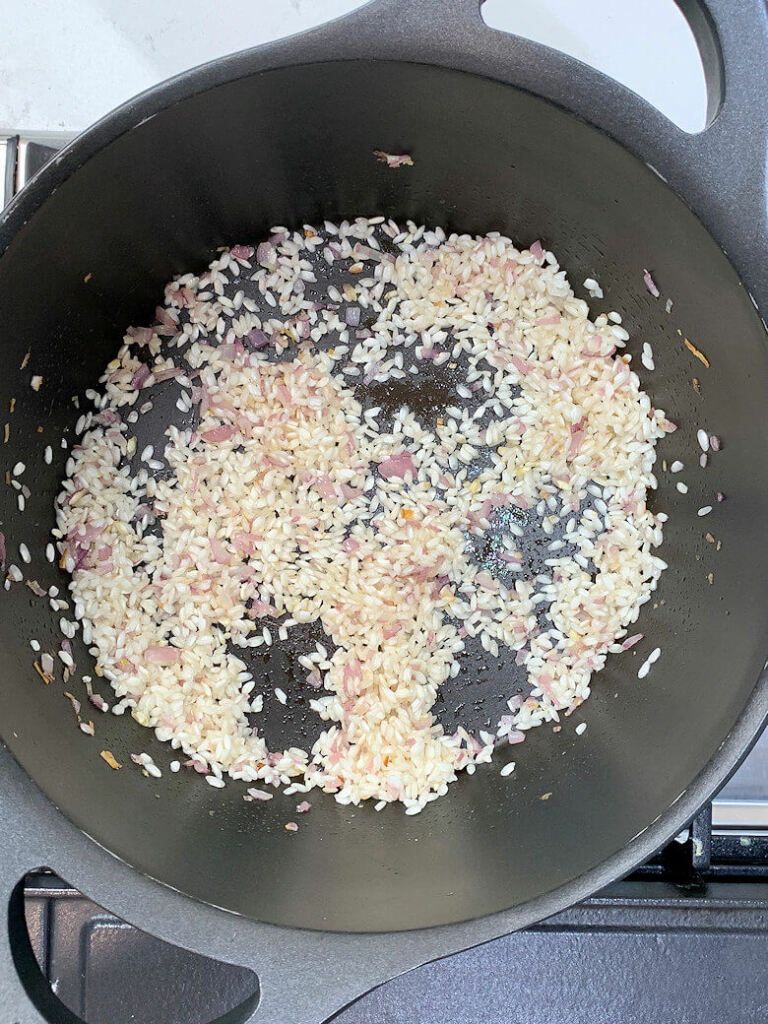
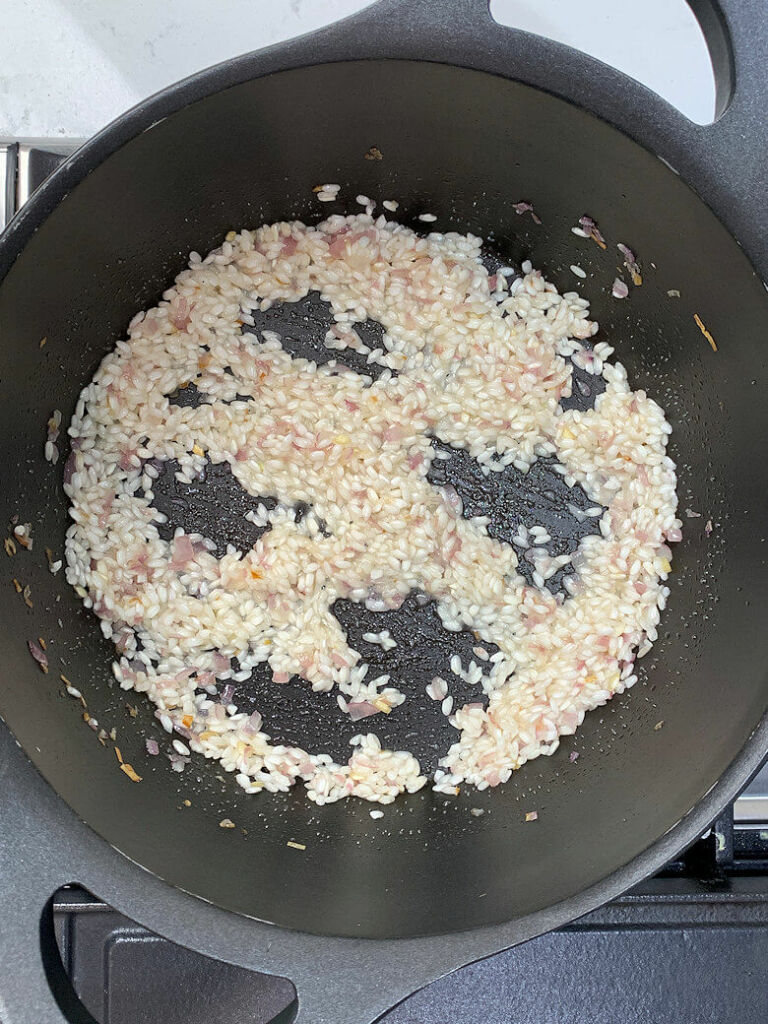
Step 3 – Deglaze (adding liquid into a pan in order to loosen the particles that are stuck to the bottom of your pan) the pan with white wine and stir until the wine is fully absorbed.
Step 4 – Add 1/2 cup of heated stock and stir until fully absorbed. Continue adding stock only after each cup is absorbed.
Keep the rice at a medium simmer for the entire cooking process.
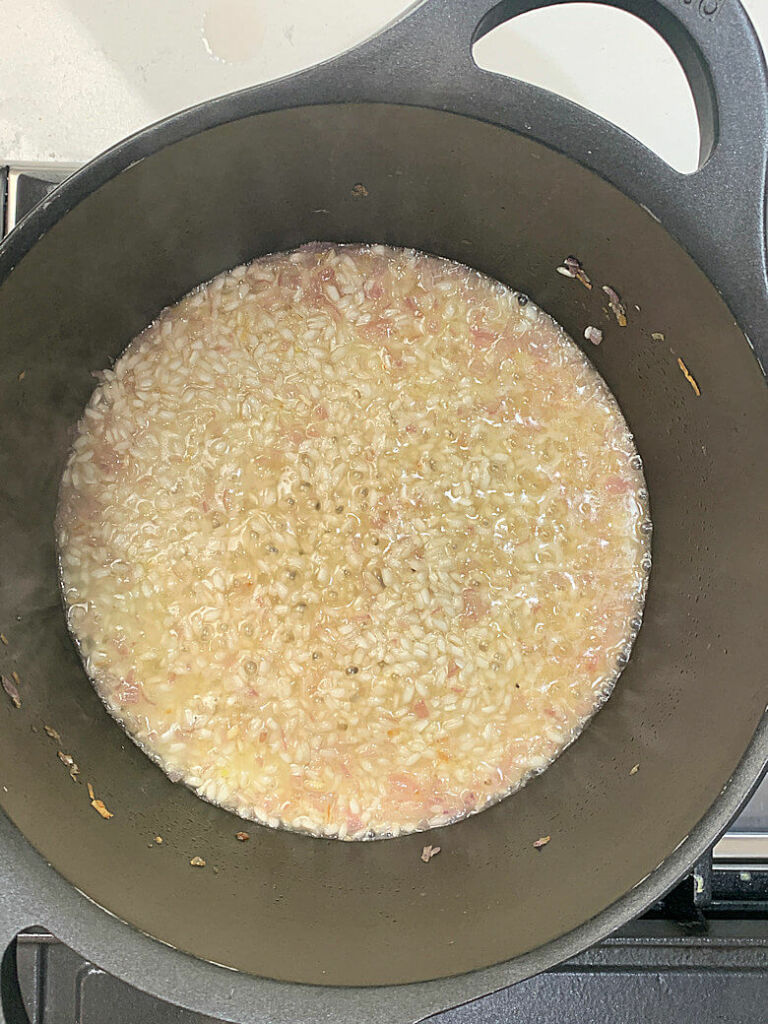
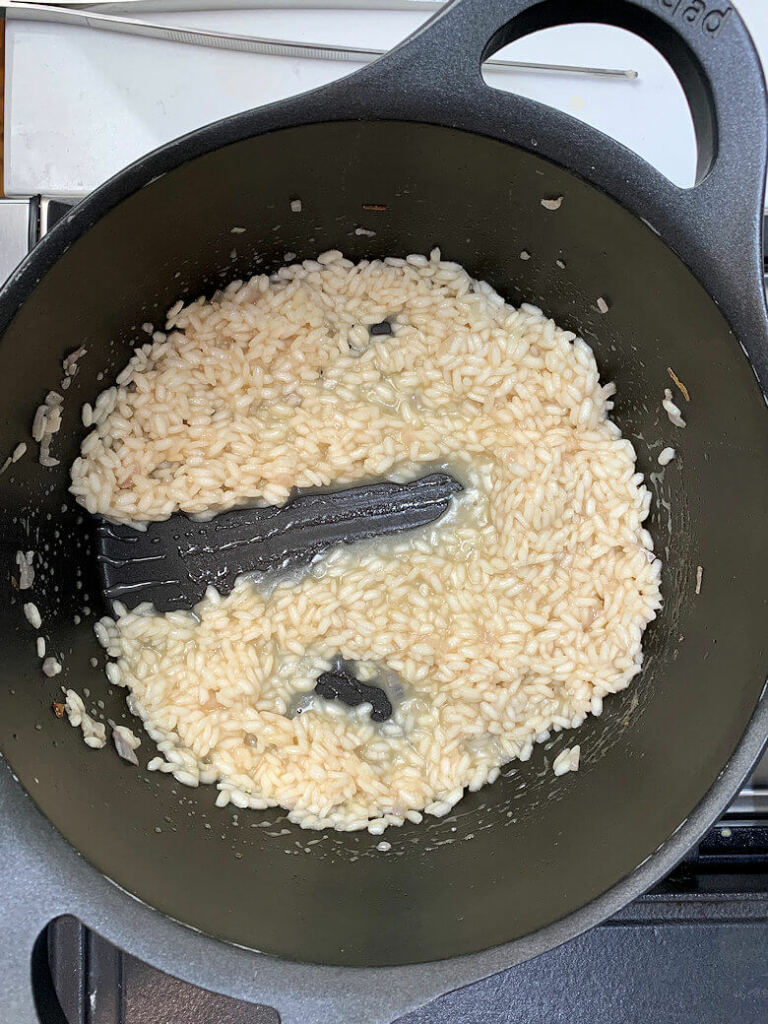
Step 5 – Continue adding heated stock in small increments until the rice is al dente (tender but slightly firm in the center) and the mixture is creamy with a consistency of thick porridge.
Ratio liquid (wine and stock) : rice = 3 : 1
Step 6 – Finish your risotto by adding butter, cheese, and season with salt & pepper.
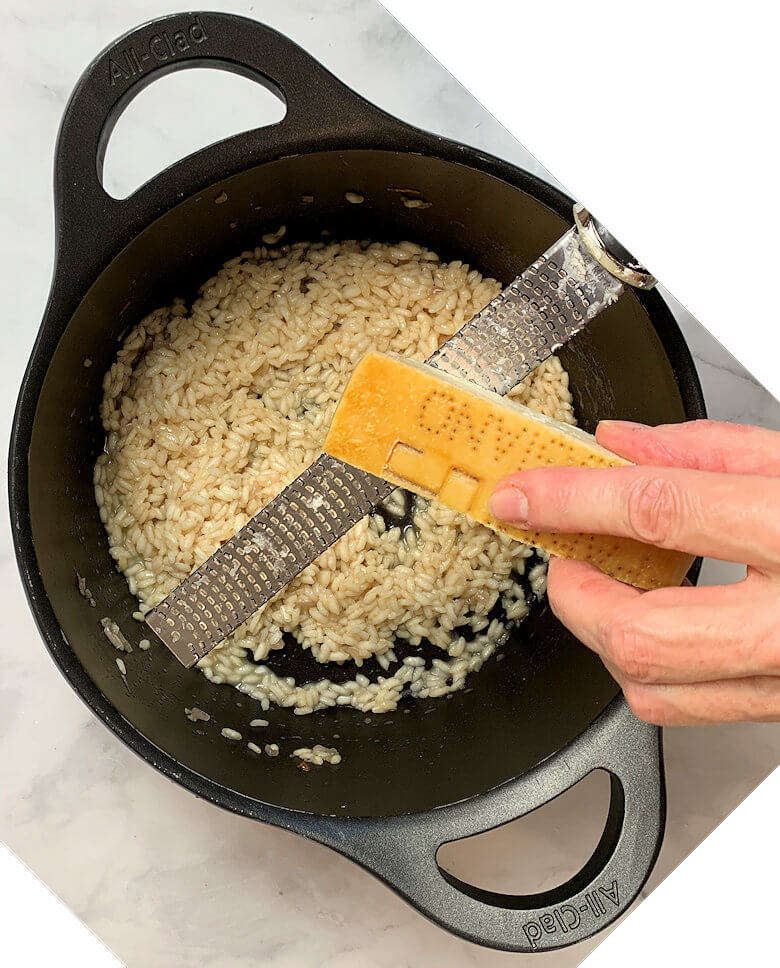
Tips for a Successful Risotto Every Time
- Use the right rice. Arborio rice is the most popular variety of short-grain superfino rice that produces a creamy risotto. Next one is Carnaroli rice, also a short-grain superfino rice with a slightly plumper grain. This rice is a little bit more expensive and less easy to find. Last one is Vialone Nano – this is rice of choice in the Veneto region of Northern Italy. This rice is commonly used for soupy-style risottos, especially those with added seafood.
- Heat the stock. It is crucial that you use a hot liquid (stock or broth) instead of a cold one. The warm stock coaxes more starch out of each rice grain. Cold stock takes longer to warm up in the risotto pan and may shock the grain into holding onto its starches while the rice itself continues to cook. This may result in a less creamy risotto.
- Toasting the rice. Adding the rice to the pan before you add the liquid and toast it for a few minutes is important because it creates a shell around each grain, allowing the grain to slowly absorb moisture without getting soggy.
- Deglaze the pan with white wine. Adding a white wine to the risotto pan releases any brown bits from the bottom of the pan (called fond) and adds a layer of flavor. The alcohol will be cooked out, while the liquid is absorbed by the rice. Make sure you select a dry white wine that you like to drink as well. Don’t go for a cheap wine as it may influence the flavor in a negative fashion.
- Monitor the heat. This is done in two ways. 1. Use a heavy saucepan, wide enough that you can stir the risotto easily or use a Dutch oven. 2. Keep the rice at a medium simmer for the entire cooking process. Too low heat and the stock will take a long time to absorb into the dish. Too high heat, and the rice may stick to the bottom of your pan.
- Stick to the ratio. This is easier said than done, as not all rice is the same. The standard varies from 1:3 to 1:4, where 1 is the rice and 3 or 4 is the liquid part (in this case white wine and stock).
- Test risotto for doneness. This may be the most difficult part, but then it may not be. As long as you end up with a risotto that you like. As with a lot of dishes, you cook a lot with your senses. Your eyes can see the texture of the risotto. When the risotto is creamy and thick as porridge and it slowly rolls back after you run a spoon through your pan; you could consider this done. Now take a bite — the rice should be mostly soft with a small bite (a little chewy) on the softer side of al dente.
- Finish the risotto. Add butter, cheese and season with salt & pepper. Now you’ve reached the point of adding meats, seafood, vegetable, fruits etc. Cheese is not a must, but
Types of Risotto
If I am going to list all the varieties of risotto you can make, I will be still typing while you’re reading this post. So, I am going to divide them into a separate categories, with a few of my own examples, if applicable. Please note that risotto can be made as a side dish or as a meal, depending on the ingredients and the volume served.
- VEGETABLE RISOTTO
- Add asparagus (Asparagus and Peas Risotto with Lemon & Tarragon)
- Add carrots (Carrot Risotto with Walnut Breadcrumb Gremolata)
- Add spinach (Spinach Risotto with Fried Egg)
- Etc.
- MEAT RISOTTO
- Add ham, cooked or prosciutto
- Add sausage
- Add ground beef/pork
- Etc.
- POULTRY RISOTTO
- Add chicken (breast or ground)
- Add turkey (breast of ground)
- Etc.
- SEAFOOD RISOTTO
- Add shrimp
- Add lobster
- Add scallops
- Etc.
- CHEESE RISOTTO
- Add any Italian cheese that melts easily
- Gorgonzola (Gorgonzola Risotto with Sundried Tomatoes)
- Add Taleggio (Risotto with Taleggio & Prosciutto)
- Add Parmesan
- Add Pecorino Romano
- Other Italian cheeses like, Fontina, Mascarpone, Ricotta, Provolone, Asiago)
- Other non-Italian cheeses like, Gouda, Cheddar, Gruyere, Emmental, Jarlsberg, Havarti etc.
- Add any Italian cheese that melts easily
- FRUIT RISOTTO
- Add pear (Pear and Wine Risotto)
- Add peach (Roasted Peach Risotto)
- Etc.
- CHANGE LIQUID
- Add coconut milk instead stock (Coconut Risotto with Cranberries and Arugula)
- Add red wine instead of white (Red Wine Risotto with Mascarpone)
- Add champagne
- Etc.
Of course there are other varieties, like mushrooms, pumpkin or squash, or combinations of the above list.
What to Do with Left-Over Risotto
- Make suppli – fried rice balls from Rome, made with arborio rice and mozzarella.
- Make arancini – fried rice balls from Sicily, made with arborio rice, mozzarella and beef and peas. The arancino is typically larger and has a conical or circular shape, which is fitting as its name translates to ‘small orange.’
- Make rice cakes or rice pancakes.
How to Make a Basic Risotto
Ingredients
- 1 tablespoon butter
- 1 shallot
- 1/4 cup white wine
- 3/4 cup Arborio rice
- 2 cups stock
- 1/4 cup Parmigiano Reggiano cheese
- 1 tablespoon butter
- salt & pepper
Instructions
- Melt the butter, add the onion and saute until tender and translucent. Do not caramelize the onions. (NOTE 1)
- Add the rice toast it by stirring it until you see white spots on the grains.
- Deglaze the pan with wine and stir until the wine is fully absorbed. (NOTE 2)
- Add 1/2 cup of heated stock and stir until fully absorbed. Continue adding stock only after each cup is absorbed. Keep the rice at a medium simmer for the entire cooking process. (NOTE 3)
- Continue adding the heated stock in small increments until the rice is al dente (tender but slightly firm in the center) and the mixture is creamy with a consistency of thick porridge. (NOTE 4)
- Finish your risotto by adding butter, cheese, and season with salt & pepper.
Notes
- If you want to add garlic, do it at this point.
- Deglazing is adding liquid into a pan in order to loosen the particles that are stuck to the bottom of your pan.
- It is crucial that you used heated stock, not cold stock.
- Adding the liquid gradually and waiting for the rice to absorb in between additions is another crucial step.
Nutrition
Nutrition information is automatically calculated, so should only be used as an approximation.


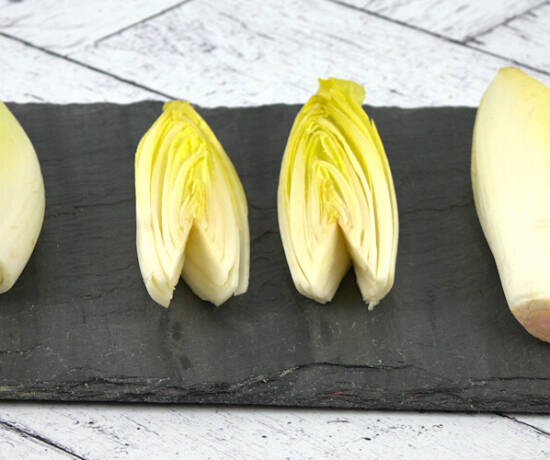
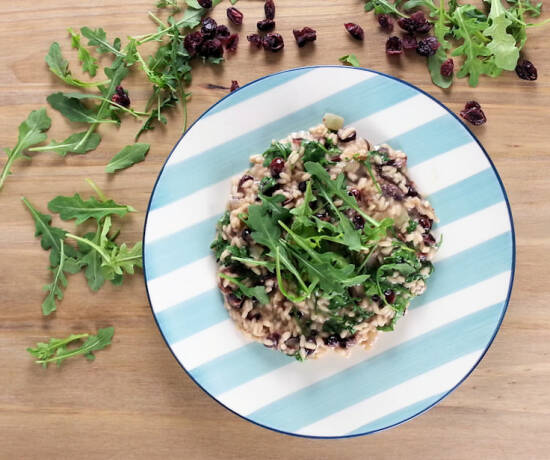

No Comments